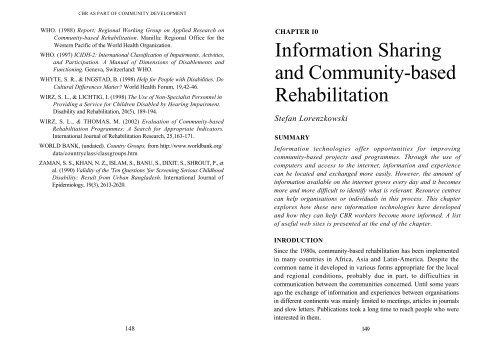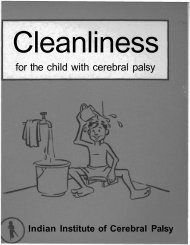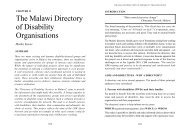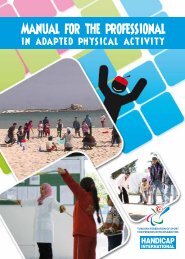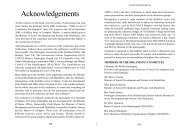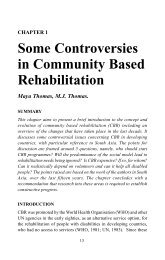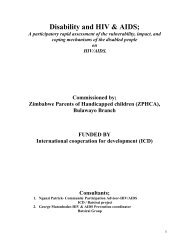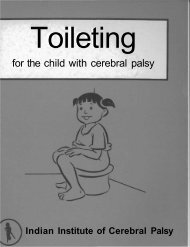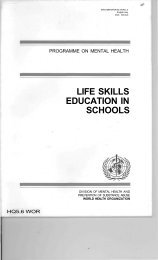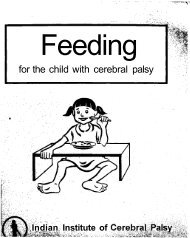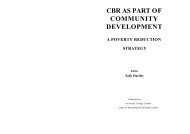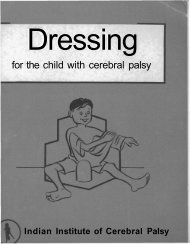Information sharing and community-based rehabilitation - Source
Information sharing and community-based rehabilitation - Source
Information sharing and community-based rehabilitation - Source
Create successful ePaper yourself
Turn your PDF publications into a flip-book with our unique Google optimized e-Paper software.
CBR AS PART OF COMMUNITY DEVELOPMENT<br />
WHO. (1988) Report; Regional Working Group on Applied Research on<br />
Community-<strong>based</strong> Rehabilitation. Manilla: Regional Office for the<br />
Western Pacific of the World Health Organization.<br />
WHO. (1997) ICIDH-2: International Classification of Impairments, Activities,<br />
<strong>and</strong> Participation. A Manual of Dimensions of Disablements <strong>and</strong><br />
Functioning. Geneva, Switzerl<strong>and</strong>: WHO.<br />
WHYTE, S. R., & INGSTAD, B. (1998) Help for People with Disabilities: Do<br />
Cultural Differences Matter? World Health Forum, 19,42-46.<br />
WIRZ, S. L., & LICHTIG, I. (1998) The Use of Non-Specialist Personnel in<br />
Providing a Service for Children Disabled by Hearing Impairment.<br />
Disability <strong>and</strong> Rehabilitation, 20(5), 189-194.<br />
WIRZ, S. L., & THOMAS, M. (2002) Evaluation of Community-<strong>based</strong><br />
Rehabilitation Programmes: A Search for Appropriate Indicators.<br />
International Journal of Rehabilitation Research, 25,163-171.<br />
WORLD BANK, (undated). Country Groups, from http://www.worldbank.org/<br />
data/countryclass/classgroups.htm<br />
ZAMAN, S. S., KHAN, N. Z. s ISLAM, S., BANU, S., DIXIT, S., SHROUT, P., et<br />
al. (1990) Validity of the 'Ten Questions 'for Screening Serious Childhood<br />
Disability: Result from Urban Bangladesh. International Journal of<br />
Epidemiology, 19(3), 2613-2620.<br />
148<br />
CHAPTER 10<br />
<strong>Information</strong> Sharing<br />
<strong>and</strong> Community-<strong>based</strong><br />
Rehabilitation<br />
Stefan Lorenzkowski<br />
SUMMARY<br />
<strong>Information</strong> technologies offer opportunities for improving<br />
<strong>community</strong>-<strong>based</strong> projects <strong>and</strong> programmes. Through the use of<br />
computers <strong>and</strong> access to the internet, information <strong>and</strong> experience<br />
can be located <strong>and</strong> exchanged more easily. However, the amount of<br />
information available on the internet grows every day <strong>and</strong> it becomes<br />
more <strong>and</strong> more difficult to identify what is relevant. Resource centres<br />
can help organisations or individuals in this process. This chapter<br />
explores how these new information technologies have developed<br />
<strong>and</strong> how they can help CBR workers become more informed. A list<br />
of useful web sites is presented at the end of the chapter.<br />
INRODUCTION<br />
Since the 1980s, <strong>community</strong>-<strong>based</strong> <strong>rehabilitation</strong> has been implemented<br />
in many countries in Africa, Asia <strong>and</strong> Latin-America. Despite the<br />
common name it developed in various forms appropriate for the local<br />
<strong>and</strong> regional conditions, probably due in part, to difficulties in<br />
communication between the communities concerned. Until some years<br />
ago the exchange of information <strong>and</strong> experiences between organisations<br />
in different continents was mainly limited to meetings, articles in journals<br />
<strong>and</strong> slow letters. Publications took a long time to reach people who were<br />
interested in them.<br />
149
CBR AS PART OF COMMUNITY DEVELOPMENT<br />
INFORMATION SHARING AND CBR<br />
During the last two decades new ways of publicising, presenting <strong>and</strong><br />
communicating, have developed through <strong>Information</strong> <strong>and</strong> Communication<br />
Technologies (ICT) such as the Internet, affordable computers <strong>and</strong> CD-<br />
ROMs.<br />
ICT have changed the ways of exchanging <strong>and</strong> obtaining information<br />
over the last decade. Personal computers have become more powerful<br />
<strong>and</strong> affordable to individuals <strong>and</strong> organisations. Floppy disks <strong>and</strong> CD-<br />
ROMs have enabled larger amounts of information to be circulated <strong>and</strong><br />
shared with people all over the world, making it possible to print documents<br />
or watch films.<br />
In particular, the increasing popularity of the Internet in the mid-1990s,<br />
improved accessibility of information <strong>and</strong> ease of communication -<br />
including the flow <strong>and</strong> exchange of experiences, knowledge <strong>and</strong><br />
publications - between organisations <strong>and</strong> individuals in different countries.<br />
Even in countries with limited <strong>and</strong> very slow internet connections, it is<br />
now possible to go online in an internet cafe, library or resource centre.<br />
These possibilities have enabled organisations to exchange information<br />
resources <strong>and</strong> experiences more easily. Publications in electronic form<br />
are easier to distribute <strong>and</strong> share. Forms <strong>and</strong> formats of communication<br />
have also changed over the last few years. It is now possible to join a<br />
mailing list, an online forum or just to browse through recent websites to<br />
get access to important <strong>and</strong> up-to-date information. Online discussion<br />
forums such as the DGroups (www.dgroups.org) <strong>and</strong> online<br />
encyclopaedias such as Wikipedia (www.wikipedia.org) now attract<br />
users worldwide.<br />
The national <strong>and</strong> international disability movements have made use of<br />
these new opportunities. Many DPOs <strong>and</strong> disability NGOs have started<br />
to publish materials <strong>and</strong> to spread news about their activities on the<br />
Internet (e.g. www.disabilityworld.org). The Internet has become a<br />
platform for lively discussion <strong>and</strong> information exchange.<br />
However, despite the many possibilities that the Internet offers, many<br />
people are still excluded or have limited access. This may be for logistical<br />
150<br />
reasons, economic or social factors, discrimination or just the unfamiliarity<br />
with the use of computers. Even with full access to the Internet, it can<br />
be difficult to find particular information. Lack of accessibility is largely<br />
a problem for organisations in developing countries. As the UNDP<br />
Sustainable Development Programme states on its website:<br />
"[...] recent statistics indicate that, contrary to many expectations, the<br />
information gap between industrialised countries <strong>and</strong><br />
developing countries is growing. Moreover, within many developing<br />
countries, the gap between 'haves' <strong>and</strong> 'have nots' is increasing at<br />
an even faster pace. Recent estimates indicate that the global<br />
number of Internet users is about 180 million, of which only 14%<br />
are in developing countries. In the African continent alone, there<br />
are around 1.3 million users; of these almost a million are in South<br />
Africa. In other words, the average number of users is 6,000 people<br />
per country - once we exclude South Africa. Some analysts have<br />
described this process of uneven development of the Internet as the<br />
emergence of the Fourth World in the global economy. "<br />
(<strong>Source</strong>: www.sdnp.undp.org/about/)<br />
The <strong>sharing</strong> of information, knowledge <strong>and</strong> experience is necessary for<br />
sustainable empowerment <strong>and</strong> support of people <strong>and</strong> organisations in<br />
middle <strong>and</strong> low income countries, so their <strong>community</strong> work in the areas<br />
of civil society, <strong>rehabilitation</strong> <strong>and</strong> disability can further be improved. A<br />
good example has been the mailing list of the Disability Knowledge <strong>and</strong><br />
Research round tables which were accompanied by a lively mailing list<br />
<strong>and</strong> online resource platform (http://www.dgroups.org/groups/<br />
disability KaR/index.cfm?op=dsp_info).<br />
<strong>Information</strong> resource centres can play an important role in identifying<br />
<strong>and</strong> adapting information to the local context in which it is required.<br />
Resource centres often function as information access points, providing<br />
internet access <strong>and</strong> training facilities, as well as important resources, in<br />
different languages. International cooperation between different centres<br />
would enable an improved <strong>sharing</strong> of knowledge <strong>and</strong> experience in the<br />
field of <strong>community</strong>-<strong>based</strong> <strong>rehabilitation</strong>.<br />
151
CBR AS PART OF COMMUNITY DEVELOPMENT<br />
One online resource centre is <strong>Source</strong> (www.asksource,info) that identifies<br />
information resources in the field of disability. Beside a key topic area<br />
about disability in development, <strong>Source</strong> offers a number of commented<br />
bibliographies, so called Key Lists. Especially for developing countries<br />
with little access to ICT, access to the internet is a problem that only<br />
partly can be addressed through the continuation of paper <strong>based</strong><br />
information or collections of information resources on CD-ROM.<br />
One example of a resource centre in a developing country is the Disability<br />
<strong>Information</strong> Resource Centre in Uzbekistan (www.dirn.uz). It is part of a<br />
network of information points in libraries <strong>and</strong> <strong>rehabilitation</strong> centres, which<br />
provide disability information resources. The network covers the eastern<br />
region of Uzbekistan. Besides the physical collection, the resource centre<br />
maintains a website that provides important documents in Russian <strong>and</strong> Uzbek.<br />
Bearing in mind some of the difficulties of accessing information on the<br />
internet, one of the problems to a new user is knowing the address of<br />
useful sites. The following list is an attempt to address this problem <strong>and</strong><br />
aims to provide the reader with a selection of addresses that have useful<br />
information about disability <strong>and</strong> <strong>community</strong> <strong>based</strong> initiatives, that provide<br />
useful <strong>and</strong> stimulating information <strong>and</strong> ideas to readers.<br />
CBR<br />
Community Based Rehabilitation (CBR) Resources<br />
Many resources related to CBR are presented on this site. The site is<br />
structured in sections: CBR websites, CBR related websites, CBR books,<br />
CBR academic programs, CBR NGOs (non-governmental<br />
organisations). The site is maintained by a PWD, who has graduate <strong>and</strong><br />
post-graduate qualifications in <strong>rehabilitation</strong> <strong>and</strong> has worked in the<br />
disabilities field in the USA. http://www.cbrresources.org<br />
Community Based Rehabilitation (CBR)<br />
STUBBS, Sue<br />
London: IDDC, [2002], 10 p.<br />
152<br />
INFORMATION SHARING AND CBR<br />
This document contains personal reflections from the IDDC co-ordinator,<br />
Sue Stubbs on CBR. They are drawn from 10 years of experience working<br />
in the field of international disability <strong>and</strong> development.<br />
http://www.iddc.org.uk/dis_dev/strategies/cbr.pdf<br />
Empowered to Differ: Stakeholders' Influences in<br />
Community-<strong>based</strong> Rehabilitation<br />
FINKENFLUGEL, Harry<br />
Rotterdam: Vrije Universiteit, 2004,202 p.<br />
'Empowered to differ' equally addresses researchers <strong>and</strong> CBR<br />
professionals. The book gives an overview about the developments in<br />
the field of <strong>community</strong>-<strong>based</strong> <strong>rehabilitation</strong> since 1978, using the examples<br />
of CBR projects in Southern Africa. Finkenflugel asks for the knowledge<br />
<strong>and</strong> the evidence for CBR <strong>and</strong> to what extent the roles, interests <strong>and</strong><br />
powers of stakeholders can contribute to this knowledge <strong>and</strong> evidence.<br />
ISBN:9077595112<br />
http://cbrresources.org/Empowered%20to%20Differ.pdf<br />
CBR : a Strategy for Rehabilitation, Equalization of<br />
Opportunities, Poverty Reduction <strong>and</strong> Social Inclusion of People<br />
with Disabilities - Joint Position Paper 2004<br />
WORLD HEALTH ORGANIZATION (WHO); International Labour<br />
Office (ILO); United Nations Educational, Scientific <strong>and</strong> Cultural<br />
Organization (UNESCO) et al Geneva: World Health Organisation<br />
(WHO), 2004, 31 p.<br />
In 1994, the ILO, WHO <strong>and</strong> UNESCO published the first version of this<br />
joint position paper. Since then progress has been made in several fields.<br />
Nevertheless many disabled people are still not reached or included in<br />
the fields of <strong>rehabilitation</strong>, employment or education. Especially disabled<br />
women, people with mental health problems or HIV/AIDS <strong>and</strong> poor<br />
disabled people are not reached. This paper underlines that <strong>community</strong><strong>based</strong><br />
<strong>rehabilitation</strong> is a strategy promoting multi-sectoral collaboration<br />
to reach different <strong>community</strong> groups. CBR has to be <strong>based</strong> on the<br />
153
CBR AS PART OF COMMUNITY DEVELOPMENT<br />
principles of equal opportunities, participation <strong>and</strong> human rights.<br />
ISBN: 92 4 159238 9<br />
http://unesdoc.unesco.org/images/0013/001377/137716e.pdf World<br />
Health Organization (WHO) Marketing <strong>and</strong> Dissemination, CH-1211<br />
Geneva 27, Switzerl<strong>and</strong><br />
Disability Coming on the Front-line in Development<br />
KONKKOLA, Kalle<br />
Essen: Behinderung und Entwicklungszusammenarbeit e.V, 2003,10 p.<br />
This article summarises the changes in development work over the last<br />
ten years. It describes the work of UN agencies, the different banks<br />
<strong>and</strong> Nordic NGOs as well as overall aspects of disability in development.<br />
Netzwerk Menschen mit Behinderung in der Einen Welt<br />
http://www.bezev.de/literatur/docs/<br />
DISABILITY%20COMING%20ON%20THE%20FRONT-<br />
LINE%20IN%20DEVELOPMENT.PDF<br />
A Manual for CBR Planners<br />
THOMAS, Maya; THOMAS, M J Eds<br />
Manual for CBR Planners Bangalore: Asia Pacific Disablity<br />
Rehabilitation Journal Group, 2003, 88 p.<br />
This manual has 13 sections. A very useful overview of the history of<br />
CBR is given, with valuable introductory reading for newcomers to the<br />
field. The following 5 sections cover needs assessment <strong>and</strong> suggestions<br />
of how to underst<strong>and</strong> local communities <strong>and</strong> encourage <strong>community</strong><br />
participation in CBR programmes. The final 6 sections are concerned<br />
with programme management issues, for example organising self-help<br />
groups, training personnel for CBR, <strong>and</strong> the sustainability of projects<br />
including evaluation <strong>and</strong> management of change<br />
http://www.aifo.it/languages/english/apdrj/<br />
Manual%20for%20cbr planners.pdf<br />
INFORMATION SHARING AND CBR<br />
POVERTYAND DISABILITY<br />
Poverty <strong>and</strong> Disability<br />
DURHAM, Michael<br />
London: Healthlink Worldwide, 2003, 4 p.<br />
This is a summary of the report "Perspectives on Disability, Poverty <strong>and</strong><br />
Technology' 1 written by Albert, B; Mcbride, R <strong>and</strong> Seddon, D. This<br />
summary defines disability <strong>and</strong> impairment, <strong>and</strong> emphasises the social<br />
model of disability. It demonstrates the links between poverty, disability<br />
<strong>and</strong> impairment, <strong>and</strong> advocates for the mainstreaming of disability into<br />
all development projects.<br />
http://www.disabilitykar.net/pdfs/odg-summarv.pdf<br />
Chronic Poverty Report 2004-05<br />
CHRONIC POVERTY RESEARCH CENTRE (CPRC)<br />
Manchester: CPRC, 2004, 140 p.<br />
This major report presents an overview of the chronic poverty facing<br />
some 400 million people, <strong>and</strong> the policy implications. The report examines<br />
what chronic poverty is <strong>and</strong> why it matters, who the chronically poor<br />
are, where they live, what causes poverty to be persistent <strong>and</strong> what<br />
should be done about it. A section of regional perspectives looks at the<br />
experience of chronic poverty in sub-Saharan Africa, South Asia, Latin<br />
America <strong>and</strong> the Caribbean, transitional countries <strong>and</strong> China. A statistical<br />
appendix brings together data on global trends on chronic poverty<br />
http://www.chronicpovertv.org/chronic_povertv_report_2004.htm<br />
Disability, Poverty <strong>and</strong> Development<br />
DEPARTMENT FOR INTERNATIONAL DEVELOPMENT (DFID)<br />
Issues London: DFID, 2000,17 p.<br />
This is a major policy document of DFID, the British Government's<br />
overseas aid department. It assesses the significance of disability as a<br />
key development issue, <strong>and</strong> its importance in relation to poverty, human<br />
rights <strong>and</strong> the achievement of internationally agreed development targets.<br />
It also sets out ways in which development cooperation, including DFID's<br />
own work, can help incorporate the rights <strong>and</strong> needs of disabled people<br />
into the mainstream of poverty reduction work <strong>and</strong> the achievement of<br />
154 155
CBR AS PART OF COMMUNITY DEVELOPMENT<br />
human rights. It is useful for disability policy-makers, NGOs <strong>and</strong> disabled<br />
people working in advocacy <strong>and</strong> development<br />
ISBN: 1 86192 252 3 http://www.dfid.govuk/pubs/files/disabilitv.pdf<br />
Measuring Welfare for Small but Vulnerable Groups : Poverty<br />
<strong>and</strong> Disability in Ug<strong>and</strong>a<br />
HOOGEVEEN, Johannes G<br />
Washington: World Bank, 2004, 30 p.<br />
When vulnerable groups such as disabled people are surveyed,<br />
representative welfare estimates from non-purposive sample surveys<br />
becomes an issue. This paper takes the example of Ug<strong>and</strong>a <strong>and</strong> describes<br />
the connections between disability, poverty, well-being <strong>and</strong> social welfare.<br />
This is possibly the first time that, for a developing country, statistically<br />
representative information on income poverty amongst disabled people<br />
has been generated.<br />
http://www-wds. worldbank.org/servlet/WDSContentServer/WDSP/<br />
IB/2004/10/14/000090341_20041014091219/Rendered/PDF/301680<br />
SP004190.pdf<br />
Poverty <strong>and</strong> Disability : a Survey of the Literature<br />
ELWAN, Ann<br />
Geneva: World Bank, 1999, 51 p.<br />
This review summarises the literature on disability <strong>and</strong> its relationship to<br />
poverty, including education, employment, income, <strong>and</strong> access to basic<br />
social services. Despite the dearth of formal analysis, it is clear that in<br />
developing countries, as in more developed areas, disabled people (<strong>and</strong><br />
their families) are more likely than the rest of the population, to live in<br />
poverty. It is a two-way relationship — disability adds to the risk of<br />
poverty, <strong>and</strong> conditions of poverty increase the risk of disability. Disability<br />
in developing countries stems largely from preventable impairments<br />
associated with communicable, maternal <strong>and</strong> perinatal disease <strong>and</strong><br />
injuries, <strong>and</strong> prevention has to remain a primary focus. An increasing<br />
INFORMATION SHARING AND CBR<br />
emphasis on <strong>community</strong>-<strong>based</strong> participatory <strong>rehabilitation</strong>, reflects<br />
growing recognition of the inadequacy of past official programmes,<br />
particularly involving specialised <strong>and</strong> exclusionary institutions.<br />
http://www-wds.worldbank.org/servlet/<br />
WDS_IBank_Servlet?pcont=details&eid=000094946_0011210532099<br />
RESEARCH<br />
Label us Able: Proactive Evaluation of Finnish Development<br />
Co-operation in Disability Issues<br />
NATIONAL RESEARCH AND DEVELOPMENT CENTRE FOR<br />
WELFARE AND HEALTH (STAKES)<br />
Evaluation report 2003:3 Helsinki: Ministry for Foreign Affairs of Finl<strong>and</strong>,<br />
2003,100 p.<br />
The Finnish Ministry for Foreign Affairs evaluates with this report its<br />
development policies for disabled people. This report looks at the last<br />
ten years of Finnish development co-operation <strong>and</strong> how a maximum<br />
impact on human rights <strong>and</strong> social development can be achieved. The<br />
four parts of the report investigate the main Finnish policies, the major<br />
findings <strong>and</strong> how disability can be mainstreamed into development issues.<br />
This evaluation report is valuable for international NGOs, disabled<br />
people's organisations <strong>and</strong> policy advisors who are looking for ways to<br />
mainstream disability. http://global.finl<strong>and</strong>.fi/evaluations/labelable/<br />
Data <strong>and</strong> Statistics on Disability in Developing Countries<br />
Arne H. Eide, Mitch E. Loeb Norwich:<br />
Disability KAR, 2005,28p.<br />
Current disability statistics is far from robust or comparable globally <strong>and</strong><br />
is particularly weak in low-income countries. There is a strong need for<br />
design development <strong>and</strong> st<strong>and</strong>ardisation of measures to be applied in<br />
both censuses <strong>and</strong> representative surveys. Important work in this regard<br />
is underway through the work by the Washington City Group <strong>and</strong> the<br />
DPO initiated research in Southern Africa. It is argued that it is important<br />
156<br />
157
CBR AS PART OF COMMUNITY DEVELOPMENT<br />
to go beyond the issue of prevalence, <strong>and</strong> to produce statistics that can<br />
compare <strong>and</strong> analyse differences in st<strong>and</strong>ards of living between disabled<br />
<strong>and</strong> non-disable persons. The disability - living conditions - poverty link<br />
should be the number one priority for broadening disability statistics (in<br />
low-income countries) from the current focus largely on prevalence.<br />
This publication explores the needs for data that can give a thorough<br />
picture of the situation for disabled people, possibilities for comparing<br />
between groups (including disabled <strong>and</strong> non-disabled people),<br />
documenting <strong>and</strong> analysing mechanisms explaining the close link between<br />
disability <strong>and</strong> poverty.<br />
http://www.disabilitykar.net/docs/thematic_stats.doc<br />
INFORMATION SHARING<br />
ICT <strong>and</strong> Development: Enabling the <strong>Information</strong> Society<br />
GUISLAIN, Pierre Ed<br />
Washington DC: World Bank, 2003, 84 p.<br />
Prepared for WSIS, this compilation addresses how ICT contributes to<br />
economic <strong>and</strong> social development <strong>and</strong> how public policy plays a critical<br />
role in reducing the digital divide. It emphasises policies related to<br />
information <strong>and</strong> communication infrastructure, including<br />
telecommunications <strong>and</strong> the Internet. It suggests, that bridging the digital<br />
divide requires first <strong>and</strong> foremost, the adoption <strong>and</strong> implementation by<br />
national governments <strong>and</strong> regulators of pro-competitive policies <strong>and</strong><br />
regulations that remove existing bottlenecks to sector growth <strong>and</strong> access.<br />
http://wbln0018.worldbank.org/ict/proiects.nsf/WebPages/<br />
3F67A7E75AF851D585256DEF007706DD'OpenDocument#ictDev<br />
http://info.worldbank.org/ict/WSIS/docs/comp_ Complete.pdf<br />
Disabled People <strong>and</strong> the Internet: Experiences, Barriers <strong>and</strong><br />
Opportunities<br />
PILLING, Doria; BARRET, Paul; FLOYD, Mike London: Joseph<br />
Rowntree Foundation, 2004, 96 p.<br />
This report explores how provision of goods <strong>and</strong> services over the Internet<br />
INFORMATION SHARING AND CBR<br />
affects people's lives. While the Internet might have some capability to<br />
provide goods, services <strong>and</strong> communication at a distance, improving<br />
access in doing so, some research findings in the early days of e-<br />
commerce suggested diminished access for some groups. This research<br />
focuses on the impact of the Internet on people with disabilities. There is<br />
the possibility that provision of information <strong>and</strong> services through the<br />
Internet might actually narrow rather than widen choices, because it<br />
might lead to the phasing out of traditional ways of providing services<br />
preferred by some disabled people. ISBN: 1 85935 185 9 web<br />
http://www.jrf.org.uk/bookshop/eBooks/1859351867.pdf<br />
EDUCATION<br />
Enabling Education Network (EENET)<br />
Excellent site focusing on inclusive education. This site is regularly<br />
updated with publications from the South. Includes a a bibliography of<br />
resources, a newsletter <strong>and</strong> information on child-to-child, parents, policy,<br />
teacher education, early childhood <strong>and</strong> communication disability. It also<br />
has some publications in documents in Arabic <strong>and</strong> other languages.<br />
http://www.eenet.org.uk<br />
A Blind Child in my Classroom : a H<strong>and</strong>book for Primary<br />
Teachers Summary<br />
GALE, Gillian; Cronin, Peter<br />
RVIB Burwood Educational Series Burwood: Royal Victorian Institute<br />
for the Blind, 2004, 8 p.<br />
This book gives ideas what can be done in a simple <strong>and</strong> effective way to<br />
include a child with vision disabilities in a class<br />
http://www.rvib.org.au/publications/pubs/<br />
A%20blind%20child%20in%20m y%20classroom%20Summarv%2011 -<br />
04.pdf<br />
158 159
CBR AS PART OF COMMUNITY DEVELOPMENT<br />
INFORMATION SHARING AND CBR<br />
HEALTH<br />
Double Burden : a Situation Analysis of HIV/AIDS <strong>and</strong> Young<br />
People with Disabilities in Rw<strong>and</strong>a <strong>and</strong> Ug<strong>and</strong>a<br />
YOUSAFZI, Aisha <strong>and</strong> EDWARDS, Karen<br />
London : Save the Children UK, 2004, 76 p.<br />
Abstract: This situation analysis gives an in-depth picture of how young<br />
people with disabilities in Rw<strong>and</strong>a <strong>and</strong> Ug<strong>and</strong>a are affected by HIV/<br />
AIDS. Results from focus group <strong>and</strong> individual interviews conducted in<br />
each country, reveal that young people with disabilities are highly<br />
vulnerable to being infected by HIV/AIDS. The study also shows how<br />
they are less likely to be able to leam how to protect themselves because<br />
of communication difficulties, discrimination by health service workers<br />
<strong>and</strong> educators, <strong>and</strong> difficulties accessing health centres. The situations<br />
of Ug<strong>and</strong>a <strong>and</strong> Rw<strong>and</strong>a are analysed separately <strong>and</strong> compared - giving<br />
a thorough insight into the extent of the problem. Recommendations on<br />
policy, programming <strong>and</strong> research are given.<br />
http://www.savethechildren.org.uk/temp/scuk/cache/cmsattach/<br />
1600_DoubleBurden.pdf<br />
Rethinking Care from the Perspective of Disabled People :<br />
Conference Report <strong>and</strong> Recommendations<br />
(Rethinking care from the perspective of disabled people, Oslo, Norway,<br />
22 - 25 April 2001.) BARNES, Colin Geneva: World Health Organization<br />
(WHO), Aug 2001, 30 p.<br />
Abstract: This conference report includes recommendations for<br />
government action, using a rights-<strong>based</strong> approach. It covers a range of<br />
care issues including a holistic approach to access; legislation <strong>and</strong> funding;<br />
medical <strong>rehabilitation</strong>; support service; <strong>and</strong> awareness raising, http<br />
://www.who.int/ncd/disabilitv/report.pdf<br />
Revising the United Nations Census : Recommendations on<br />
Disability<br />
MBOGONI, Margaret, ME, Angela (First Meeting of the Washington<br />
Group on Disability Statistics, Washington, 18-20 February 2002)<br />
Washington: Centre for Disease Control <strong>and</strong> Prevention, 2002, 27 p.<br />
This paper describes the issues concerned with the revision of the<br />
disability section of the United Nations Principles <strong>and</strong> Recommendations<br />
for Population <strong>and</strong> Housing Censuses. The discussion includes how the<br />
newly pubhshed International Classification of Functioning, Disability <strong>and</strong><br />
Health (ICF) can be incorporated in the recommendations. Issues for<br />
consideration are: (i) new approaches in defining disability; (ii) a new list<br />
of types of disabilities <strong>based</strong> on the ICF; (iii) improvement of the wording<br />
<strong>and</strong> structure of questions to identify persons with disabilities; (iv)<br />
improvement of the dialogue between users <strong>and</strong> producers; <strong>and</strong> (v) the<br />
need to perform cognitive <strong>and</strong> quantitative testing of questions on disability.<br />
The paper also gives an overview of how countries have used the census<br />
to collect data on disability <strong>and</strong> it underlines advantages <strong>and</strong> disadvantages<br />
of its use highlighting its importance in the collection of information on<br />
persons with disabilities, particularly in developing countries.<br />
http://www.cdc.gov/nchs/about/otheract/citygroup/products/<br />
me_mbogonil.htm<br />
Towards a Common Language for Functioning, Disability <strong>and</strong><br />
Health : ICF The International Classification of Functioning,<br />
Disability <strong>and</strong> Health<br />
WORLD HEALTH ORGANIZATION (WHO) Geneva: WHO, 2002, 22 p.<br />
This is the introduction to WHO's International Classification of<br />
Functioning, Disability <strong>and</strong> Health, also known as the Beginner's Guide.<br />
It provides an introduction to the ICF <strong>and</strong> its use. It sets out what the<br />
ICF offers to health workers, planners <strong>and</strong> policy-makers. It also includes<br />
a list of organisations,agencies <strong>and</strong> NGOs who are part of the ICF<br />
collaborating network. http://www3.who.int/icf7beginners/bg.pdf<br />
160<br />
161


